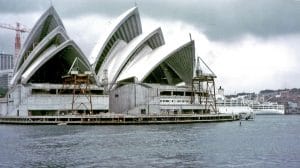Born on the Mediterranean island of Corsica, during World War II Bertony joined the French navy to study naval engineering at Saint-Tropez, and was recruited there into another job: spy. He was twice captured by the Nazis, but escaped both times, once by jumping off the train taking him to a concentration camp. General Charles De Gaulle praised his “courageous discipline” and Bertony was awarded the Croix de Guerre. He emigrated to Australia in 1953 and worked in the Northern Territory’s uranium mines, but by 1960 had found work with a construction company in Queensland as an engineer. Not long after, the company was awarded the majority of a new project in New South Wales: the Sydney Opera House.

The building was designed by Danish architect Jørn Utzon, but it was completely unclear how the distinctive shells could be built, as each supporting arch would have a different shape and size. Bertony realized that it was just a matter of “schoolboy geometry” to figure out how to build them; they merely had to be within a half-inch tolerance. He set out doing the required calculations — more than 30,000 of them — and he did them all by hand. That took long enough that nervous executives in the company assigned David Evans, a junior engineer, to verify Bertony’s equations on a computer. That was a tough assignment in the early ’60s: there was only one computer in the entire country large enough for the job, an IBM 7090 at the Defence Research Centre’s Weapons Research Establishment in South Australia. That computer was busy during the day, and the government approved its use at night. Evans learned computer programming and found that all of Bertony’s equations were correct. While others could have done the calculations, “I doubt if there was anyone with Joe’s genius to see how to develop the telescopic truss and to build the ribs with it, or to do a dozen other things of importance on that site,” Evans said later. “It would have taken many minds and many rounds of trial and error, and a much longer time and a much bigger budget, to get those ribs in the air if Joe hadn’t been there,” Evans said later. “Other solutions would have lacked his elegance and genius.”
The trusses Bertony made possible held up each of the 2,194 precast concrete segments while they were glued into place with epoxy, one at a time — it was the first large structure to use that technique. After the Opera House was completed in 1973, Bertony went back to other civil engineering tasks for the company, such as the Pheasants’ Nest Bridge across the Nepean River. He retired to his home in Hornsby, north of Sydney, and donated his hand-written Opera House calculations to Sydney’s Museum of Applied Arts and Sciences. At 93 he bought himself an electric car — and still worked on projects, including a wind power generation facility in Scotland. Bertony died at his home on April 7, at 97.
